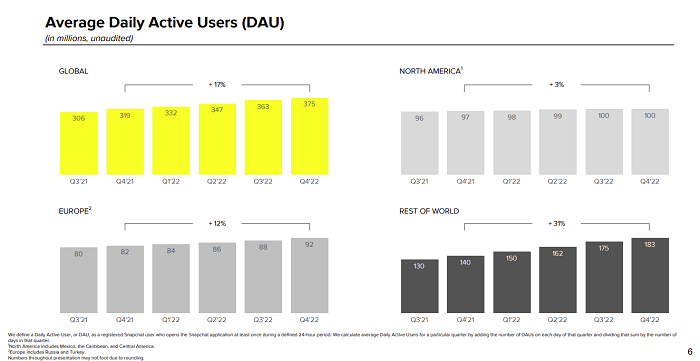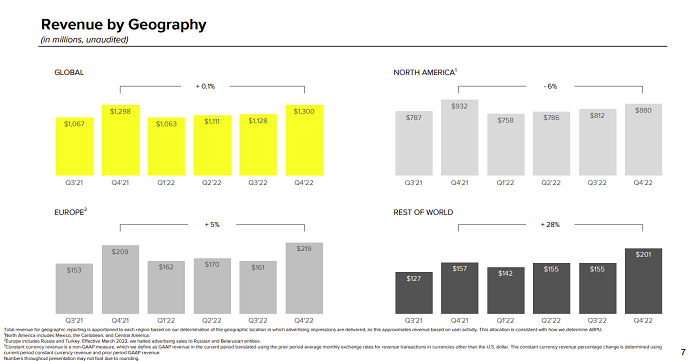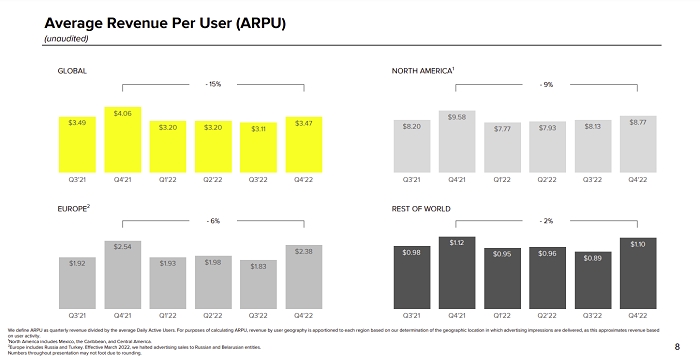SOCIAL
Snapchat Adds 12 Million Users in Q4, Posts Lower Than Expected Revenue Result

Snapchat added 12 million more active users in Q4 2022, and Snapchat+ subscriptions continue to rise, but company revenue missed market estimates, in another mixed result for the private social app.
First off, on users – as noted, Snap added 12 million more actives, taking it to 375 million DAU.
As you can see, North American user growth is still flat, while European users saw a slight uptick. But it’s the ‘Rest of the World’, specifically India, which is driving Snap growth.
Which is helping to boost the overall usage numbers, and expand opportunity. But on the revenue side, it’s not pushing things forward in a significant way.

As you can see in this chart, Snapchat’s revenue has increased, but a key problem here is that it’s still reliant on the US and Canada for the majority of that spend, with other markets trailing well behind on the revenue front.

In this chart, you can see that Snap’s Revenue Per User has actually declined year-on-year – so while it is growing, it’s not bringing in revenue at equivalent scale, and it’s even going backwards in some respects.
Which is why its stagnant growth in North America is a problem – though Snap has also seen take-up of its Snapchat+ subscription service increase.
“In Q4, our subscription service Snapchat+ reached over 2.0 million paying subscribers. Snapchat+ offers exclusive, experimental, and pre-release features, and in Q4 we launched new features such as Custom Story Expiration and Custom Notification Sounds, providing subscribers with over 12 exclusive features.”
That’s a handy additional revenue stream, but as with all social media subscription services (including Twitter Blue), take-up is generally limited, and at 2 million subscribers, that’s still only 0.5% of Snapchat’s active user base that’s been willing to pay extra for these add-on elements.
Snap has also faced challenges in rebuilding its ad business, in the wake of Apple’s iOS 14 update, which has impacted data collection, and Snap CEO Evan Spiegel says they still have some way to go on this yet:
“We continue to face significant headwinds as we look to accelerate revenue growth, and we are making progress driving improved return on investment for advertisers and innovating to deepen the engagement of our community.”
Snap has seen improvement in its commerce integrations, which includes digital items for Bitmoji avatars which Snap is eventually looking to translate into real-world item sales as well. Snap also says that it’s facilitated over than 161 million product trials by over 35 million Snapchatters for Walmart, leveraging its Catalog-Powered Shopping Lenses at-scale.

Those point to bigger opportunities, but right now, amid the broader economic downturn, and restrictions on data collection and targeting, Snapchat is in a tough spot, and will be for some time yet.
Essentially, then, you’re banking on Snap’s future, and its advanced tools that could help it better align with expanded AR and VR use. And Snap is seemingly in a good position on this front – though again, the impacts of the last year, which also forced Snap into lay-offs, will also have some effect.
Really, then, the results here are relative to your perspective.
For advertisers, more Snap users means more potential reach – but most of Snap’s growth is coming from outside the US. More advanced AR activations could become a bigger deal in future, but it depends on how you’re looking to connect, and product fit.
Investors won’t be overly happy with the numbers, but there are positive signs on the horizon. It’s just that the horizon, in this respect, remains well in the distance at this stage.
SOCIAL
Snapchat Explores New Messaging Retention Feature: A Game-Changer or Risky Move?

In a recent announcement, Snapchat revealed a groundbreaking update that challenges its traditional design ethos. The platform is experimenting with an option that allows users to defy the 24-hour auto-delete rule, a feature synonymous with Snapchat’s ephemeral messaging model.
The proposed change aims to introduce a “Never delete” option in messaging retention settings, aligning Snapchat more closely with conventional messaging apps. While this move may blur Snapchat’s distinctive selling point, Snap appears convinced of its necessity.
According to Snap, the decision stems from user feedback and a commitment to innovation based on user needs. The company aims to provide greater flexibility and control over conversations, catering to the preferences of its community.
Currently undergoing trials in select markets, the new feature empowers users to adjust retention settings on a conversation-by-conversation basis. Flexibility remains paramount, with participants able to modify settings within chats and receive in-chat notifications to ensure transparency.
Snapchat underscores that the default auto-delete feature will persist, reinforcing its design philosophy centered on ephemerality. However, with the app gaining traction as a primary messaging platform, the option offers users a means to preserve longer chat histories.
The update marks a pivotal moment for Snapchat, renowned for its disappearing message premise, especially popular among younger demographics. Retaining this focus has been pivotal to Snapchat’s identity, but the shift suggests a broader strategy aimed at diversifying its user base.
This strategy may appeal particularly to older demographics, potentially extending Snapchat’s relevance as users age. By emulating features of conventional messaging platforms, Snapchat seeks to enhance its appeal and broaden its reach.
Yet, the introduction of message retention poses questions about Snapchat’s uniqueness. While addressing user demands, the risk of diluting Snapchat’s distinctiveness looms large.
As Snapchat ventures into uncharted territory, the outcome of this experiment remains uncertain. Will message retention propel Snapchat to new heights, or will it compromise the platform’s uniqueness?
Only time will tell.
SOCIAL
Catering to specific audience boosts your business, says accountant turned coach

While it is tempting to try to appeal to a broad audience, the founder of alcohol-free coaching service Just the Tonic, Sandra Parker, believes the best thing you can do for your business is focus on your niche. Here’s how she did just that.
When running a business, reaching out to as many clients as possible can be tempting. But it also risks making your marketing “too generic,” warns Sandra Parker, the founder of Just The Tonic Coaching.
“From the very start of my business, I knew exactly who I could help and who I couldn’t,” Parker told My Biggest Lessons.
Parker struggled with alcohol dependence as a young professional. Today, her business targets high-achieving individuals who face challenges similar to those she had early in her career.
“I understand their frustrations, I understand their fears, and I understand their coping mechanisms and the stories they’re telling themselves,” Parker said. “Because of that, I’m able to market very effectively, to speak in a language that they understand, and am able to reach them.”Â
“I believe that it’s really important that you know exactly who your customer or your client is, and you target them, and you resist the temptation to make your marketing too generic to try and reach everyone,” she explained.
“If you speak specifically to your target clients, you will reach them, and I believe that’s the way that you’re going to be more successful.
Watch the video for more of Sandra Parker’s biggest lessons.
SOCIAL
Instagram Tests Live-Stream Games to Enhance Engagement

Instagram’s testing out some new options to help spice up your live-streams in the app, with some live broadcasters now able to select a game that they can play with viewers in-stream.
As you can see in these example screens, posted by Ahmed Ghanem, some creators now have the option to play either “This or That”, a question and answer prompt that you can share with your viewers, or “Trivia”, to generate more engagement within your IG live-streams.
That could be a simple way to spark more conversation and interaction, which could then lead into further engagement opportunities from your live audience.
Meta’s been exploring more ways to make live-streaming a bigger consideration for IG creators, with a view to live-streams potentially catching on with more users.
That includes the gradual expansion of its “Stars” live-stream donation program, giving more creators in more regions a means to accept donations from live-stream viewers, while back in December, Instagram also added some new options to make it easier to go live using third-party tools via desktop PCs.
Live streaming has been a major shift in China, where shopping live-streams, in particular, have led to massive opportunities for streaming platforms. They haven’t caught on in the same way in Western regions, but as TikTok and YouTube look to push live-stream adoption, there is still a chance that they will become a much bigger element in future.
Which is why IG is also trying to stay in touch, and add more ways for its creators to engage via streams. Live-stream games is another element within this, which could make this a better community-building, and potentially sales-driving option.
We’ve asked Instagram for more information on this test, and we’ll update this post if/when we hear back.
-

 PPC6 days ago
PPC6 days ago19 Best SEO Tools in 2024 (For Every Use Case)
-

 MARKETING7 days ago
MARKETING7 days agoEcommerce evolution: Blurring the lines between B2B and B2C
-
SEARCHENGINES5 days ago
Daily Search Forum Recap: April 19, 2024
-
SEARCHENGINES6 days ago
Daily Search Forum Recap: April 18, 2024
-

 WORDPRESS6 days ago
WORDPRESS6 days agoHow to Make $5000 of Passive Income Every Month in WordPress
-

 SEO7 days ago
SEO7 days ago2024 WordPress Vulnerability Report Shows Errors Sites Keep Making
-

 WORDPRESS7 days ago
WORDPRESS7 days ago10 Amazing WordPress Design Resouces – WordPress.com News
-

 SEO6 days ago
SEO6 days ago25 WordPress Alternatives Best For SEO
















You must be logged in to post a comment Login